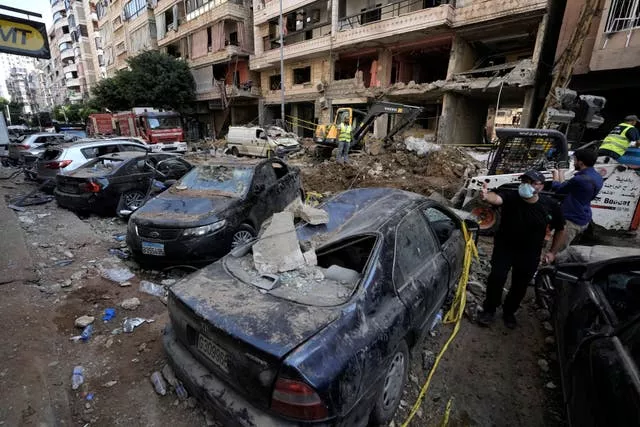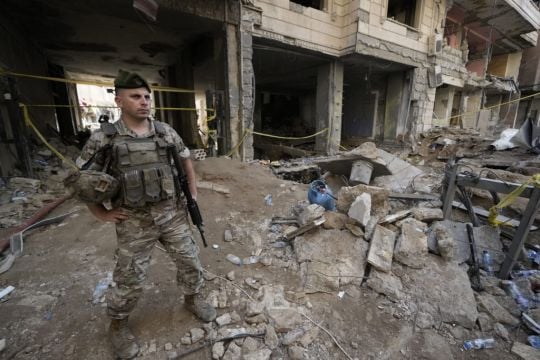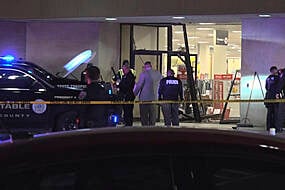The death toll from an Israeli air strike on a Beirut suburb has risen to 37, including seven women and three children, Lebanon’s health minister said.
Firass Abiad told reporters that 68 people were also wounded, of whom 15 remain in hospital, in the deadliest Israeli air strike on Beirut since the 2006 Israel-Hezbollah war.
Among those killed were Ibrahim Akil, who was in charge of Hezbollah’s elite Radwan Force, and Ahmed Wahbi, another senior commander in the group’s military wing.
Wahbi was described as a commander who played major roles within the group for decades and was imprisoned in an Israeli jail in south Lebanon in 1984.
Hezbollah said he was one of the “field commanders” of a 1997 ambush in southern Lebanon that left 12 Israeli troops dead.

Hezbollah announced overnight that 15 of its operatives were killed by Israeli forces but did not elaborate on the location of these deaths. Meanwhile, the Israeli army spokesperson, Nadav Shoshani, said on Saturday a total of 16 Hezbollah fighters were killed in the strike.
Israel earlier said Akil had been meeting with other militants in the basement of the apartment block.
Israeli defence minister Yoav Gallant said the attack thwarted Hezbollah’s chain of command while taking out Akil, who was responsible for Israeli deaths.
“This is our commitment to the fallen and their loved ones. This is our commitment to the residents of the north. And this is a clear message to all those who seek to harm us,” he posted on X, formerly Twitter, referring to northern Israel, which has been the target of Hezbollah rocket attacks during Israel’s nearly year-long war with Hamas in Gaza.
Israel launched the rare strike in the densely populated southern Beirut neighbourhood on Friday afternoon during rush hour as people returned home from work and students from schools.
On Saturday morning, Hezbollah’s media office took journalists on a tour of the scene of the air strike where workers were still digging through the rubble.
Lebanese troops cordoned off the area preventing people from reaching the building that was knocked down as members of the Lebanese Red Cross stood nearby to take any bodies recovered from under the rubble.
In the US, White House national security adviser Jake Sullivan called the death of Ibrahim Akil “a good outcome” and said that he planned to speak with Israeli officials later on Saturday about the operation.

Akil, the main target of the Friday strike, had been wanted by the US for years for his alleged role in the 1983 bombing of the US embassy in Beirut and in taking American and German hostages in Lebanon in the 1980s.
He was under US sanctions and, in 2023, the US State Department announced a reward of up to seven million dollars (£5.2 million) for information leading to his “identification, location, arrest, and/or conviction”.
“That individual has American blood on his hands and has a rewards for justice price on his head,” Sullivan said.
“He is somebody who the United States promised long ago we would do everything we could to see brought to justice.”
Mr Sullivan said the moment was also meaningful for the American victims.
“You know 1983 seems like a long time ago,” he said. “But for a lot of families and a lot of people, they’re still living with it every day.”

Friday’s deadly strike came hours after Hezbollah launched one of its most intense bombardments of northern Israel in nearly a year of fighting, largely targeting Israeli military sites.
Israel’s Iron Dome missile defence system intercepted most of the Katyusha rockets.
Israel and Hezbollah have traded fire regularly since Hamas’s October 7 assault on southern Israel ignited the Israeli military’s devastating offensive in Gaza.
But previous cross-border attacks have largely struck areas in northern Israel that had been evacuated and less-populated parts of southern Lebanon.
Earlier this week, Israel’s security cabinet said stopping Hezbollah’s attacks in the country’s north to allow residents to return to their homes is now an official war goal, as it considers a wider military operation in Lebanon that could spark an all-out conflict.
The tit-for-tat strikes have forced tens of thousands of people to evacuate their homes in both southern Lebanon and northern Israel.







